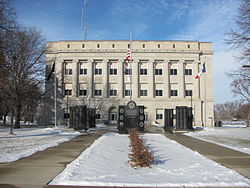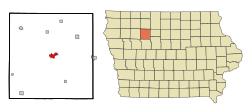Pocahontas, Iowa
| Pocahontas, Iowa | |
|---|---|
| City | |

|
|
| Nickname(s): The Princess City | |
 Location of Pocahontas, Iowa |
|
| Coordinates: 42°44′4″N 94°40′23″W / 42.73444°N 94.67306°WCoordinates: 42°44′4″N 94°40′23″W / 42.73444°N 94.67306°W | |
| Country |
|
| State |
|
| County | Pocahontas |
| Incorporated | May 16, 1892 |
| Government | |
| • Mayor | Dick Gruber |
| Area | |
| • Total | 2.02 sq mi (5.23 km2) |
| • Land | 2.02 sq mi (5.23 km2) |
| • Water | 0 sq mi (0 km2) |
| Elevation | 1,220 ft (372 m) |
| Population (2010) | |
| • Total | 1,789 |
| • Estimate (2012) | 1,744 |
| • Density | 885.6/sq mi (341.9/km2) |
| Time zone | Central (CST) (UTC-6) |
| • Summer (DST) | CDT (UTC-5) |
| ZIP code | 50574 |
| Area code(s) | 712 |
| FIPS code | 19-63975 |
| GNIS feature ID | 0460342 |
| Website | http://www.pocahontasiowa.com |
Pocahontas is a city in and the county seat of Pocahontas County, Iowa, United States. The population was 1,789 in the 2010 census, a decline from the 1,970 population in 2000.
This city was named after the Native American princess from Jamestown, Virginia. Other geographical names in the county related to the colony at Jamestown are Rolfe, Powhatan Township and Varina.
Pocahontas was incorporated as a city on May 16, 1892.
During the April 2011 Iowa-Wisconsin tornado outbreak, several tornadoes hit Pocahontas County and the surrounding area. No one was injured and there were no fatalities. The largest was an EF4 and touched-down West of town.
Pocahontas's longitude and latitude coordinates in decimal form are 42.734476, -94.673017.
According to the United States Census Bureau, the city has a total area of 2.02 square miles (5.23 km2), all of it land.
As of the census of 2010, there were 1,789 people, 852 households, and 493 families residing in the city. The population density was 885.6 inhabitants per square mile (341.9/km2). There were 953 housing units at an average density of 471.8 per square mile (182.2/km2). The racial makeup of the city was 98.3% White, 0.3% African American, 0.1% Native American, 0.1% Asian, 0.1% Pacific Islander, 0.1% from other races, and 1.0% from two or more races. Hispanic or Latino of any race were 1.3% of the population.
...
Wikipedia
